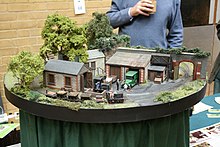
A pizza layout is a model railway laid out as a circle of the smallest workable radius of curve, on the smallest possible square or circular baseboard. This baseboard can be so small as to look as if it would fit into a pizza box, hence the name. [1] [2] [3]
Contents
Pizza layouts are not serious scale models, but are to provide a little humour. Despite their simplicity, they are rarely built by beginners but are usually light relief for an experienced modeller. As they are quick to build and lower budget they are often used as a theme for exhibitions and contests. [4] Many are also seasonally themed, such as Christmas layouts. They often provide an opportunity to experiment with a different gauge and scale from a modeller's regular.

Building this minimum-size layout requires a small gauge. Most pizzas use 9mm gauge, as for N gauge. [5] Z gauge [6] and the esoteric smaller gauges would be useful too, but their costs are more than 9mm and there are fewer options available. Other gauges up to the popular H0/OO 16.5mm gauge are also used, [2] but almost only as narrow-gauge models.
Most pizzas model narrow-gauge railways. This combines the narrow physical gauge needed with a larger and more visible scale. Narrow-gauge prototypes also have short wheelbases, slow running speeds and so are often more accepting of tight curve radii. Where standard gauge is modelled, this is only for N, Z or smaller gauges, [2] H0 requiring a size greater than the usual 'pizza' format, [2] although this can just be achieved in 2' diameter. [7]
For an 00-9 or H0e pizza, using 9mm gauge and either 4mm or 3.5mm scale, a workable minimum curve radius is 6", for an overall baseboard diameter of 15 inches (380 mm), within the pizza box format. [3] Some model companies, such as Tomix, even produce extra-small radius curves of 4" radius, for modelling trams. These have been used to model at N gauge within a 9" baseboard. [6]
Gn15-gauge models one of the smallest prototypical gauges, 15 inch minimum-gauge railways. This gives the greatest combination of small curve radius and largest scale. [8]
Nn3 Z gauge [9] Z gauge has even been used to make layouts inside a large glass bottle. [10]
The layout is a simple circular loop. Points are limited to just one, perhaps two, small sidings and these are more decorative than useful for shunting. A siding to the outside of the loop [2] requires a larger baseboard. A siding inside the loop may do so too: the siding's radius must be smaller than that of the running loop, which is already close to the minimum radius. [9] Allowing the loop to be a little larger, so as to permit a tighter siding curve within it, means a larger loop and baseboard. This can be done most compactly by stretching the circular loop to an oval, but keeping the same radius with an added straight; the point comes off the straight portion. In rare cases, a fiddle yard has been incorporated into a hidden part of the layout. [11]
Although rare, some pizza layouts have also used multi-level spiral layouts, with something of the rabbit warren to them. [12]